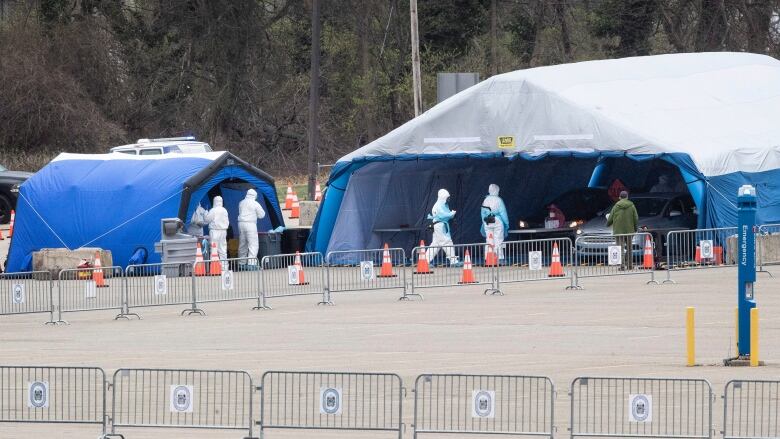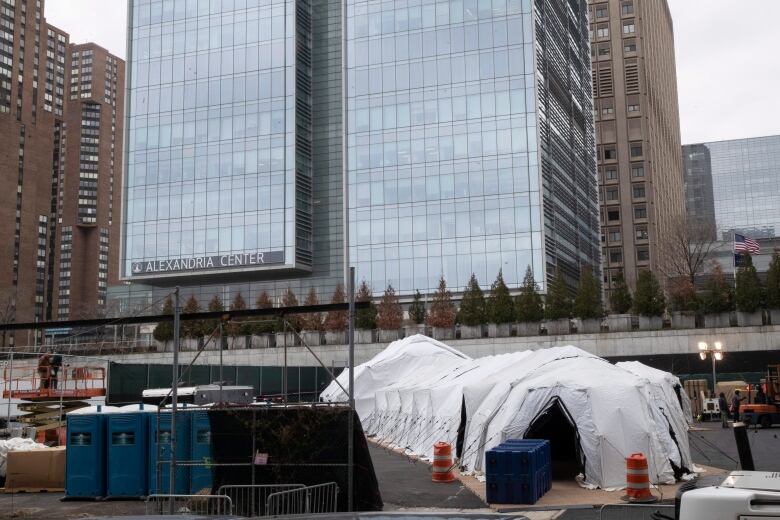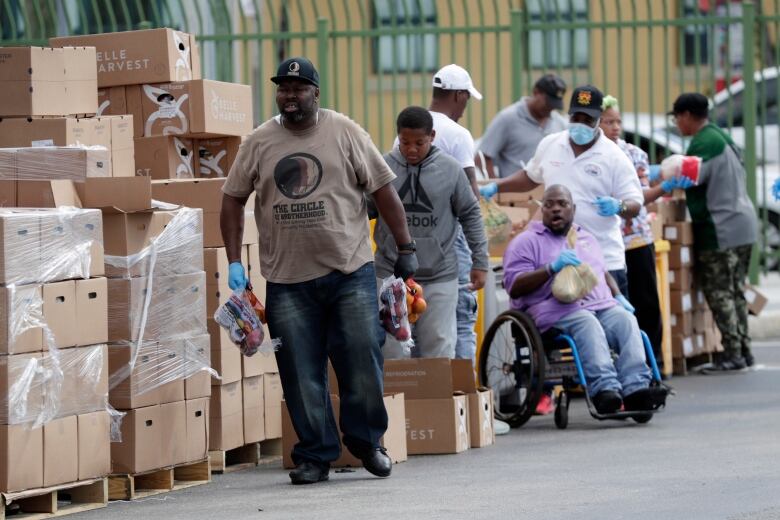Coronavirus impact spreads across U.S., with much of the population under stay-at-home orders
Cases spike in Michigan and in Louisiana, where Mardi Gras revelry possibly fuelled transmission

New York, which is experiencing more coronavirus deaths and infections than any other U.S. state, is showing tentative signs of slowing the spread of the virus, Gov.Andrew Cuomo said Wednesday, while the health crisis deepened in hard-hit New Orleans and elsewhere.
The rate of hospitalizations in New York has slowed in recent days, Cuomo said, with numbers he called "almost too good to be true." Butmuch more work needed to be done, he said.
New Orleans, where large crowds celebrated Mardi Gras about a month ago, was on track to become the next U.S. epicentre, with the world'shighest growth rate in coronavirus cases.
Cuomo announced new "density-control" steps he said sought to contain the virus, with New York Cityhome to more than eightmillion peopleclosing some public streets to vehicles and opening them instead to pedestrians to facilitate social distancingto avoid infections.
At a news conference Wednesday, Cuomo said the city also would ban basketball and other contact sports in parks, first on a voluntary basis, as long as people comply.
"Our closeness makes us vulnerable," said Cuomo, who has emerged as a leading national voice on the U.S. coronavirus outbreak.
Cuomo said Wednesday morning that the state's total known cases now number 30,811, with 285 deaths. Just over 3,800 people were hospitalized, with 888 being treated in intensive care units.

Hospitalizations were doubling every two days as of Sunday, but by Monday, the trend showed hospitalizations were doubling every 3.4 days, and by Tuesday, the rate was 4.7 days.Cuomo said this evidence suggested such "density-control measures" as closing businesses and limiting gatherings, while burdensome, may be working.
"This is a very good sign and a positive sign, again not 100 per centsure it holds, or it's accurate, but the arrows are headed in the right direction," Cuomo said.
"You're on 100 per centof the time no matter what," said Dr. Jolion McGreevy, medical director of The Mount Sinai Hospital emergency department in New York City. "It's been a month of full force, and that's certainly very stressful."
McGreevy said in the past week hospitals are receiving more serious cases where patients arein need of life-saving intervention.
"These are people in severe respiratory distress, needing to be intubated and needing the intensive care unit," he said.
Even as city officials struggled to contain the health crisis, the impact was increasingly being felt beyond the firsthot spots of New York, California and Washington.
U.S. President Donald Trump issued the latest major federal disaster declarations, along with those three states, for Louisiana and Iowa to help them cope.
A number of other U.S. states have also applied for major disaster relief status in recent days including Florida, Texas, New Jersey, North Carolina, Missouri, Maryland and South Carolina.
'This is as bad as Katrina or worse'
Louisiana reported a spike in infections with 1,388 total confirmed cases and 46 deaths as of mid-Tuesday, according to the state'shealth department.
Dr. Rebekah Gee, who until January was Louisiana's health secretary and now heads up Louisiana State University's health-care services division, said that it was Mardi Gras, when 1.4 million tourists descended on New Orleans, that fuelled the city's outbreak.
"It's a highly infectious virus and Mardi Gras happened when the virus was in the United States but before the CDC [Centers for Disease Control and Prevention] and national leaders had really educated the public or even acknowledged the extent to which it was in the U.S.," Gee said.
New Orleans restaurant owner Ronnie Evans said everyone in New Orleans was "freaking out."
"People are still coming out, but they're scared. This is as bad as Katrina or worse," said Evans, owner of Blue Oak BBQ, referring to the hurricane that devastated the city in 2005.

The governors of at least 18 states have issued stay-at-home directives affecting about half the U.S. population of roughly 330 million people. The sweeping orders are aimed at slowing the spread of the pathogen but have upended daily life as schools and businesses shutter indefinitely.
That included Michigan, where the latest figures released Wednesday show nearly 2,300 people have tested positive and at least 45 have died.Iowa and Kentucky also reported increases in cases, with Iowa marking its first death related to the virus on Tuesday.
Biden criticizes Florida
Nationwide, more than 53,000 people have been diagnosed with COVID-19, the disease caused by the virus, with at least 730 deaths.
U.S. lawmakers and the Trump administration reached a deal early Wednesday for a bipartisan $2-trillion stimulus package to help businesses and millions of Americans hit by the economic fallout.
Trump on Tuesday initially said he wanted to reopen the country by Easter Sunday, April 12, but later told reporters he would listen to recommendations from the nation's top health officials. It's also not clear even if the White House exhorted businesses to pick up after Easter what the response would look like, given the stay-at-home orders issued at state level.
WATCH |Scenes of desolation around the world:
Anticipating more hospitalizations and deaths, state and local governments have been scrambling to obtain masks, gloves and safety gear for health-care workers and ramping up the number of available hospital beds for virus patients.
But not all states have taken the same approach. While Mississippi Gov. Tate Reeves has advised people to avoid gatherings of more than 10 people and didn't discourage families from adhering to a self-imposed lockdown if they feel it is necessary, he also said:"Mississippi's never going to be China, Mississippi's never going to be North Korea."

Florida Gov. Ron DeSantis, meanwhile, encountered criticism for a slow response in ordering closures of some of the state's most popular beaches.
Democratic presidential candidate Joe Biden criticized DeSantis in a statement released Wednesday morning.
"While other large states continue to take strong, urgent, and sweeping action to stop the spread of COVID-19, Florida has not," said Biden. "I urge Governor DeSantis to let the experts speak to the public and explain why this is the case."
DeSantis's most controversial decision came earlier this week, when he issued an executive order requiring anyone coming into the state from the greater New York area which has seen the nation's biggest virus spike to self-isolate for 14 days. Florida officials have said most of the people in the state who have contracted the virus recently travelled elsewhere or had contact with others who had.
Navy ship to be employed in California's fight
California, like New York, has been hard hit. A tally by Johns Hopkins University on Tuesday found the state has more than2,500 cases, with at least 50 deaths.
Los Angeles Mayor Eric Garcetti said his city might see a surge in coronavirus cases based on the ferocious outbreak in the New York area.

"We are anywhere from about six to 12 days behind what we are seeing in New York City" Garcetti said Tuesday.
California Gov. GavinNewsom announced that the 1,000-bed navy hospital ship Mercy was on its way to Los Angeles from San Diego and would arrive Friday and could be ready as early as Saturday to provide care to non-coronavirus patients in order to ease the crush on hospitals.
With files from CBC News and The Associated Press














_(720p).jpg)


 OFFICIAL HD MUSIC VIDEO.jpg)
.jpg)



























































































